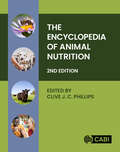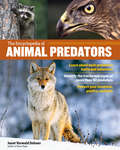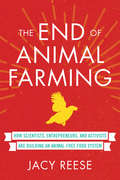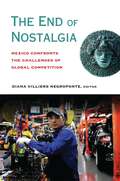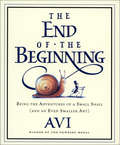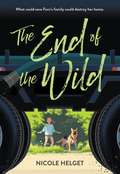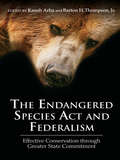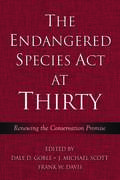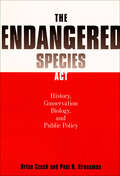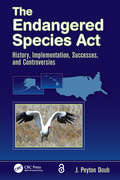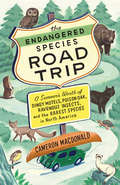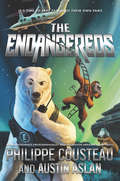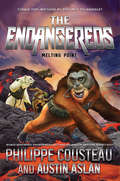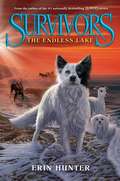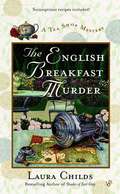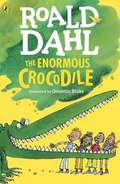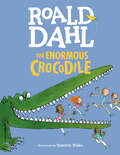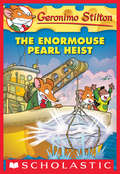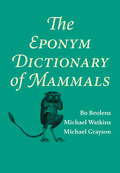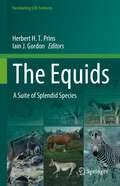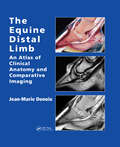- Table View
- List View
The Encyclopedia of Animal Nutrition
by C.J.C. PhillipsThe Encyclopedia of Animal Nutrition covers animal nutrition across a wide range of disciplines, including physiology, biochemistry, veterinary medicine and feed technology. Through approximately 3000 entries ranging from short definitions to more discursive articles, it discusses and illuminates on all aspects of this important topic. The book: - Covers every type of animal managed in developing and developed countries, from livestock and companion animals to those commonly found in laboratories and zoos; - Includes human nutrition as well as fish species used in aquaculture, and farmed invertebrates such as honey bees and prawns, and animals of localised significance such as yaks, snakes, crocodiles, and asses; - Addresses important societal topics in relation to nutrition, including welfare, environmental pollution, disease, resource use, and animal product quality. Written by a global team of contributors and expert section editors, this book is an important resource for researchers, students and advisers of animal nutrition and feed, as well as anyone interested in agriculture, the food industry, veterinary science, zoology, physiology, human health, animal science, and animal behaviour.
The Encyclopedia of Animal Predators: Learn about Each Predator’s Traits and Behaviors; Identify the Tracks and Signs of More Than 50 Predators; Protect Your Livestock, Poultry, and Pets
by Janet Vorwald DohnerLearn to identify threatening species through tracks, scat, and the damage they leave behind. Fascinating profiles of more than 50 predatory mammals, birds, and reptiles teach farmers, ranchers, homesteaders, and backyard-animal raisers how to prevent their livestock, poultry, and pets from becoming prey. By understanding how predators think and behave, where and how they live, and how they attack and kill prey, you’ll be able to interpret the potential threats surrounding your home. Whether you have a vested interest in protecting your pets and livestock or are simply spellbound by wild predators, this is the book for you!
The End (Almost)
by Jim BentonA new picture book from the hilarious author of the bestselling Dear Dumb Diary series!When Donut the bear is told his story is over and he has to leave, he donut want to do it. After all, he hasn't had a chance to have any fun! Will Donut's sneaky schemes and elaborate disguises be enough to keep his story from ending?Donut's silly antics in this clever picture book from New York Times bestselling author Jim Benton are sure to delight kids who never want their favorite stories toreach The End.
The End of Animal Farming: How Scientists, Entrepreneurs, and Activists Are Building an Animal-Free Food System
by Jacy ReeseA bold yet realistic vision of how technology and social change are creating a food system in which we no longer use animals to produce meat, dairy, or eggsMichael Pollan's The Omnivore's Dilemma and Jonathan Safran Foer's Eating Animals brought widespread attention to the disturbing realities of factory farming. The End of Animal Farming pushes this conversation forward by outlining a strategic roadmap to a humane, ethical, and efficient food system in which slaughterhouses are obsolete--where the tastes of even the most die-hard meat eater are satisfied by innovative food technologies like cultured meats and plant-based protein. Social scientist and animal advocate Jacy Reese analyzes the social forces leading us toward the downfall of animal agriculture, the technology making this change possible for the meat-hungry public, and the activism driving consumer demand for plant-based and cultured foods. Reese contextualizes the issue of factory farming--the inhumane system of industrial farming that 95 percent of farmed animals endure--as part of humanity's expanding moral circle. Humanity increasingly treats nonhuman animals, from household pets to orca whales, with respect and kindness, and Reese argues that farmed animals are the next step. Reese applies an analytical lens of "effective altruism," the burgeoning philosophy of using evidence-based research to maximize one's positive impact in the world, in order to better understand which strategies can help expand the moral circle now and in the future. The End of Animal Farming is not a scolding treatise or a prescription for an ascetic diet. Reese invites readers--vegan and non-vegan--to consider one of the most important and transformational social movements of the coming decades.
The End of Nostalgia
by Diana Villiers NegroponteToday's Mexico is strongly determined to become a full player in the globalizing international economy. It has increased its manufacturing output in areas such as automobiles and electronics, and both corporate and government sectors would like to take greater strides toward being a full global player. But do the underlying institutional and cultural elements exist to support such an economic effort?In The End of Nostalgia, editor Diana Villiers Negroponte and colleagues from both sides of the Rio Grande examine the path that Mexico will likely take in the near future. It remains a land in transition, from a one-party political system steeped in a colonial Spanish past toward a modern liberal democracy with open markets. What steps are necessary for this proud nation to continue its momentum toward effective participation in a highly competitive world?Contributors:Armando Chacón is the research director at the Mexican Institute for Competitiveness.Arturo Franco has worked with Cementos de Mexico (CEMEX) and the World Bank. He was a Global Leadership fellow at the World Economic Forum on Latin America, 2008-11.Eduardo Guerrero is a partner at Lantía Consultores in Mexico City, where he works on security assessment. He joined the Secretaría de Gobernación in December 2012.Andrés Rozental holds the permanent rank of Eminent Ambassador of Mexico. He is president of Rozental & Asociados and is a nonresident senior fellow at the Brookings Institution.Christopher Wilson is an associate at the Mexico Institute of the Woodrow Wilson International Center for Scholars.Duncan Wood is a member of the Mexican National Research System and editorial adviser to Reforma newspaper. Since January 2013, he has been the director of the Mexico Institute at the Woodrow Wilson International Center for Scholars.
The End of the Beginning: Being the Adventures of a Small Snail (and an Even Smaller Ant)
by Avi Tricia TusaAvon the snail has never had an adventure. And adventure, he has heard, is the key to a happy life. So with his new friend Edward the ant, Avon sets out on a journey to find the excitement his life has been missing. This modern fable is filled with funny--and profound--insights about the meaning of things . . . great and small.
The End of the Wild
by Nicole HelgetA modern, beautifully written story set against the backdrop of the controversial issue of fracking that explores the timely themes of poverty, environmental protection, what makes a family, and finding your place in the world.Eleven-year-old Fern's rundown home borders a pristine forest, where her impoverished family hunts and forages for food. It's also her refuge from the crushing responsibility of caring for her wild younger brothers and PTSD-stricken stepfather. But when a fracking company rolls into town, Fern realizes that her special grove could be ripped away, and no one else seems to care.Her stepfather thinks a job with the frackers could help pull the family out of poverty. Her wealthy grandfather--who wants to take custody of Fern and her brothers--likes the business it brings to his manufacturing company. Facing adversity from all sides, can one young girl make a difference in the fate of her family and their way of life?
The Endangered Florida Panther
by Margaret Goff ClarkExamines the physical characteristics, habits, and natural environment of the endangered Florida panther and what is being done to save it from extinction.
The Endangered Species Act and Federalism: Effective Conservation through Greater State Commitment
by Jr. Barton H. Thompson Kaush ArhaStates today play a major role in implementing and enforcing environmental laws such as the Clean Air Act, Clean Water Act, and the Resource Conservation and Recovery Act. A thirty year review of ESA identified state leadership in species conservation as a necessary element in better conserving the nation‘s imperiled species, yet the theoretical and practical reasons and applications of an enhanced state role are little understood and have not been subjected to any meaningful analysis. This book, for the first time, presents the legal and policy analysis for federalism considerations in implementing ESA. The book undertakes a comprehensive analysis of the economic rationale for federalism in ESA administration; compares administration of ESA to other major environmental statutes; reviews various tools under the existing Act to enhance state role in species conservation; evaluates major case studies to determine roles the state can play in species conservation and recovery; and concludes with policy recommendations to encourage greater state involvement in species conservation.
The Endangered Species Act at Thirty: Renewing the Conservation Promise
by Dale D. Goble J. Michael Scott Frank W. DavisThe Endangered Species Act at Thirty is a comprehensive, multidisciplinary review of issues surrounding the Endangered Species Act, with a specific focus on the act's actual implementation record over the past thirty years. The result of a unique, multi-year collaboration among stakeholder groups from across the political spectrum, the two volumes offer a dispassionate consideration of a highly polarized topic. Renewing the Conservation Promise, Volume 1, puts the reader in a better position to make informed decisions about future directions in biodiversity conservation by elevating the policy debate from its current state of divisive polemics to a more-constructive analysis. It helps the reader understand how the Endangered Species Act has been implemented, the consequences of that implementation, and how the act could be changed to better serve the needs of both the species it is designed to protect and the people who must live within its mandates. Volume 2, which examines philosophical, biological, and economic dimensions of the act in greater detail, will be published in 2006. As debate over reforming the Endangered Species Act heats up in the coming months, these two books will be essential references for policy analysts and lawmakers; professionals involved with environmental law, science, or management; and academic researchers and students concerned with environmental law, policy, management, or science.
The Endangered Species Act: History, Conservation Biology, and Public Policy
by Brian Czech Paul R. KrausmanThe new model of policy design theory frames the discussion regarding the frequently analyzed Endangered Species Act (ESA) in this historical perspective.Since the 1970s, the Endangered Species Act (ESA), by virtue of its regulatory impact, has been a frequent subject of policy analysis. In this comprehensive history and critique of the ESA, Brian Czech and Paul R. Krausman incorporate the new model of policy design theory to frame a larger discussion about conservation biology and American democracy.Czech and Krausman provide a historical background of endangered species policy that integrates natural history, socioeconomic trends, political movements, and professional developments. Outlining the controversies surrounding the ESA, they find a connection between challenges to species conservation and challenges to democracy. After an assessment of ESA analyses that have been performed from traditional perspectives, they engage policy design theory to review the structural logic of the ESA, analyzing each clause of the legislation for its application of the fundamental elements of democracy. To address the technical legitimacy of ESA, they propose two new genetic considerations—functional genome size and molecular clock speed—to supplement phylogenetic distinctiveness as criteria with which to prioritize species for conservation. Next, they systematically describe the socioeconomic context of ESA by assessing and classifying the causes of species endangerment.A hybrid of policy analysis and ecological assessment, The Endangered Species Act: History, Conservation Biology, and Public Policy will appeal to scholars and students in the fields of natural resource policy and law, conservation biology, political science, wildlife ecology, and environmental history, and to professionals at agencies involved in wildlife conservation.
The Endangered Species Act: History, Implementation, Successes, and Controversies
by J. Peyton DoubThe complex regulations of the Endangered Species Act can be challenging for environmental professionals who must comply with them or assist clients in compliance. This volume discusses the Act using clear scientific prose that all professionals can readily comprehend. It explores the history and the basic scientific theory underlying the Act. It provides an overview of its key provisions and examines the Act in the context of other key environmental planning statutes. The book also details the regulatory processes faced by other government agencies and private developers who must routinely ensure that their actions are in compliance.
The Endangered Species Road Trip
by Cameron MacdonaldBill Bryson meets John Vaillant in this life list quest to see the rarest species in North America.Crammed into a minivan with wife, toddler, infant, and dog, accompanied by mounds of toys, diapers, tent, sleeping bags, and other paraphernalia, Cameron MacDonald embarks on a road trip of a lifetime to observe North America's rarest species. In California, the family camps in the brutally hot Mojave, where he observes a desert tortoise-"the size and shape of a bike helmet and the colour of gravel" sitting motionless in the shade of a scrubby sagebush. In Yellowstone, after driving through unseasonal snow, he manages to spot a rare black wolf and numerous grizzlies, which, unfortunately, call forth a crowd of "grizzly gawkers." The journey takes the MacDonald family from British Columbia, along the west coast of the U.S., through the Southwest and Florida, up the east coast of the U.S., and finally to eastern Canada and then back home to BC.Along the way, MacDonald offers fascinating details about the natural history of the endangered species he seeks, as well as threats like overpopulation, commercial fishing, and climate change that are driving them towards extinction.
The Endangereds
by Austin Aslan Philippe CousteauIt’s time for animals to take fate into their own paws! The Endangereds is the first book in a thrilling new adventure series by world-renowned environmentalist and Emmy-nominated host of Xploration Awesome Planet Philippe Cousteau and award-winning TURBO Racers author Austin Aslan. Innocent animals are in trouble: temperatures are climbing, tides are rising, and nature is suffering. Someone needs to step in to rescue animals from extinction. Someone needs to turn this mess around, before it’s too late.And that someone is . . . the Endangereds, the unlikeliest heroes you’ll ever meet—a superstrong polar bear, a pangolin with a genius for engineering, an extremely sarcastic narwhal, and an orangutan with a big dream. Together, these four daredevils are determined to save endangered species across the globe, no matter what the risk. Rappelling into an underground cavern to save the day? No problem. Looping video footage to sneak through buildings unnoticed? Got it covered. Opening a doorknob? Okay, pretty hard without thumbs. But don’t worry. No matter what it takes, the Endangereds will get the job done. But when two of their friends get kidnapped by a villain with a dastardly agenda, the team finds themselves up to their snouts in trouble. Can the Endangereds save the day? Or will this villain put humans and animals alike on the extinction list? The A-Team meets the animal kingdom in the first book in the thrilling new adventure series from the host of Xploration Awesome Planet Philippe Cousteau and award-winning author Austin Aslan.
The Endangereds: Melting Point
by Austin Aslan Philippe CousteauIt’s time for animals to take fate into their own paws! The Endangereds: The Melting Point is the second book in a thrilling new adventure series by world-renowned environmentalist and Emmy-nominated host of Xploration Awesome Planet Philippe Cousteau and award-winning TURBO Racers author Austin Aslan. Around the world, temperatures are rising, ice caps are melting, and innocent animals are in trouble. Humans had their chance to fix it and failed. It’s time for the animals to take their fate into their own paws. It’s time for . . . the Endangereds. When word reaches the Endangereds that one of the last of a species of nearly extinct sloths is in trouble, the team don’t hesitate to strap on their gear, fire up their helicopter, and rush off into action. But this time their mission is complicated by the appearance an unexpected foe—an animal faction bent on saving the world by making humans extinct. It’s the toughest assignment the Endangereds have faced yet as the faction will stop at nothing to take back the world, one biome at a time. It’s a rollicking new high-stakes turn in the thrilling environmental-adventure series by Philippe Cousteau, the world-renowned environmentalist and Emmy-nominated host of Awesome Planet, and Austin Aslan, the award-winning author of the TURBO Racers book series.
The Endless Lake: The Endless Lake (Survivors #5)
by Erin HunterFrom Erin Hunter, #1 nationally bestselling author of the Warriors and Seekers series, comes book five in the New York Times bestselling Survivors series, which Kirkus Reviews praised as "wild and wonderful adventure" in a starred review. This action-packed novel will thrill fans of animal fantasy stories and readers who have been howling for more of Lucky and the dogs of the Wild Pack.At the edge of a strange lake that seems to stretch on forever, Lucky and his Pack are about to discover even more new dangers. With the Fierce Dogs on their trail and the Storm of Dogs looming on the horizon, every dog will have to fight for survival--or be swept away.
The Ends of the World: Volcanic Apocalypses, Lethal Oceans and Our Quest to Understand Earth’s Past Mass Extinctions
by Peter BrannenApocalypse, now? Death by fire, ice, poison gas, suffocation, asteroid. At five moments through history life on Earth was dragged to the very edge of extinction. Now, armed with revolutionary technology, scientists are uncovering clues about what caused these catastrophes. Deep-diving into past worlds of dragonflies the size of seagulls and fishes with guillotines for mouths, they explore how – against all the odds – life survived and what these ominous chapters can tell us about our future.
The English Breakfast Murder (Tea Shop Mystery #4)
by Laura Childs[From the back Cover:] "Indigo Tea Shop owner Theodosia Browning is about to embark on her first turtle crawl--and her latest murder investigation... It is a truly exhilarating experience for Theo--helping Charleston's Sea Turtle Protection League shepherd hundreds of tiny green loggerheads safely into the sea. But just as she's about to celebrate all her hard work with some hearty Lung Ching tea and spicy gumbo, she spots a dead body bobbing in the waves. It turns out to be local art dealer Harper Fisk--a man with an eye for fine antiques. Could his death have anything to do with the sunken treasure and gold bullion rumored to be somewhere near Halliehurst Beach? Deep in her heart, Theo knows that murder is indeed brewing in Charleston--and it's up to her to get to the bottom of it before the culprit's greed stirs him to kill again... Includes mouthwatering recipes and easy-to-follow instructions for tea dyeing!" There are also tips for holding themed tea parties. Look for more books in the Tea Shop Mysteries series in the Bookshare collection.
The Enormous Crocodile
by Roald DahlThe Enormous Crocodile loves to eat fresh, juicy children from the town near his river. Eventhough he's wicked and cunning, the other animals in the jungle know just how to foil his plans!
The Enormous Crocodile
by Roald DahlFrom the bestselling author of Charlie and the Chocolate Factory and The BFG! This picture book has a beautiful full-color interior and large trim to feature Quentin Blake's iconic art.The Enormous Crocodile is a horrid greedy grumptious brute who loves to guzzle up little boys and girls. But the other animals have had enough of his cunning tricks, so they scheme to get the better of this foul fiend, once and for all!
The Enormouse Pearl Heist: The Enormouse Pearl Heist (Geronimo Stilton #51)
by Geronimo StiltonPetunia Pretty Paws, Bugsy Wugsy, Benjamin and I were exploring underwater at Pirate Island one day, when we made an amazing discovery. It was an huge clam that had an enormouse pearl inside! I was so excited about this extremely rare, precious pearl that I wrote a special feature about it in the Rodent's Gazette. But that attracted good attention--and bad! The enormouse pearl was in danger. Would my friends and I be able to protect it?<P><p> <i>Advisory: Bookshare has learned that this book offers only partial accessibility. We have kept it in the collection because it is useful for some of our members. To explore further access options with us, please contact us through the Book Quality link on the right sidebar. Benetech is actively working on projects to improve accessibility issues such as these. </i>
The Eponym Dictionary of Mammals
by Michael Watkins Bo Beolens Michael GraysonJust who was the Przewalski after whom Przewalski's horse was named? Or Husson, the eponym for the rat Hydromys hussoni? Or the Geoffroy whose name is forever linked to Geoffroy's cat? This unique reference provides a brief look at the real lives behind the scientific and vernacular mammal names one encounters in field guides, textbooks, journal articles, and other scholarly works.Arranged to mirror standard dictionaries, the more than 1,300 entries included here explain the origins of over 2,000 mammal species names. Each bio-sketch lists the scientific and common-language names of all species named after the person, outlines the individual's major contributions to mammalogy and other branches of zoology, and includes brief information about his or her mammalian namesake's distribution. The two appendixes list scientific and common names for ease of reference, and, where appropriate, individual entries include mammals commonly—but mistakenly—believed to be named after people.The Eponym Dictionary of Mammals is a highly readable and informative guide to the people whose names are immortalized in mammal nomenclature.
The Eponym Dictionary of Mammals
by Michael Watkins Bo Beolens Michael GraysonLearn the origins of over 2,000 mammal species names with this informative reference guide.Just who was the Przewalski after whom Przewalski's horse was named? Or Husson, the eponym for the rat Hydromys hussoni? Or the Geoffroy whose name is forever linked to Geoffroy's cat? This unique reference provides a brief look at the real lives behind the scientific and vernacular mammal names one encounters in field guides, textbooks, journal articles, and other scholarly works.Arranged to mirror standard dictionaries, the more than 1,300 entries included here explain the origins of over 2,000 mammal species names. Each bio-sketch lists the scientific and common-language names of all species named after the person, outlines the individual’s major contributions to mammalogy and other branches of zoology, and includes brief information about his or her mammalian namesake’s distribution. The two appendixes list scientific and common names for ease of reference, and, where appropriate, individual entries include mammals commonly—but mistakenly—believed to be named after people.The Eponym Dictionary of Mammals is a highly readable and informative guide to the people whose names are immortalized in mammal nomenclature.“A small treasure trove of information about the people whose names are immortalized in mammalian nomenclature. Given that we mammalogists are prone to ancestor worship, I expect it to be a best-seller.” —Don E. Wilson, Journal of Mammalian Evolution“This is a great reference for the mammalogy professional or student, or the curious naturalist.” —Wildlife Activist“This is a splendid book which fills a real gap in zoological literature.” —Nicholas Gould, International Zoo News
The Equids: A Suite of Splendid Species (Fascinating Life Sciences)
by Herbert H. T. Prins Iain J. GordonThe narrative of the progression of the ‘horse family’ through geological time, from dog-sized fruit-eating animals with four toes on their front and three toes on their hind legs, to the valiant long-legged, single-toed modern grazing horses, beloved by racing enthusiasts, is the poster child of evolution. However, like the rhinos or tapirs, the horse-like zebras, wild asses, kulans, kiangs, onagers, and the real horses are often portrayed as being past their evolutionary peak as compared to the more recently evolved ruminants (especially bovids and deer) which now dominate the grazing niche. That story of a species group over its evolutionary zenith is compelling, but anyone who has travelled in the remote savannas of Africa or the cold wild deserts of Central Asia is awed with herds of glorious animals that clearly do not ruminate. It appears as though these, so-named ‘hind-gut fermenters’, are perhaps much better adapted to these environments than one is led to believe. The purpose of this book is to dispel the myth of the inferior Equidae by describing, and investigating, the evolutionary and ecological journey of the horse family in all its glory.
The Equine Distal Limb: An Atlas of Clinical Anatomy and Comparative Imaging
by Jean-Marie DenoixJean-Marie Denoix is the world's leading equine musculoskeletal system anatomist and has become one of the foremost equine diagnostic ultrasonographers. There is therefore nobody better to compile a reference atlas of the clinical anatomy of the foot, pastern and fetlock, correlated with images obtained by radiography, diagnostic ultrasonography and magnetic resonance imaging. Advanced imaging techniques require in depth knowledge of anatomy for accurate interpretation and especially when using magnetic resonance imaging this must be a 3-dimensional concept of anatomy.
